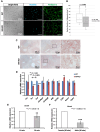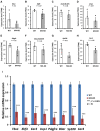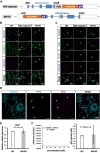Weight Gain With Advancing Age Is Controlled by the Muscarinic Acetylcholine Receptor M4 in Male Mice
- PMID: 40179260
- PMCID: PMC12012353
- DOI: 10.1210/endocr/bqaf064
Weight Gain With Advancing Age Is Controlled by the Muscarinic Acetylcholine Receptor M4 in Male Mice
Abstract
Obesity is characterized by the excessive accumulation of adipose tissue, and it is a serious global health issue. Understanding the pathology of obesity is crucial for developing effective interventions. In this study, we investigated the role of muscarinic acetylcholine receptor M4 (mAChR-M4) in the regulation of obesity in Chrm4-knockout (M4-KO) mice. Male M4-KO mice showed higher weight gain and accumulation of white adipose tissue (WAT) with advancing age than the wild-type mice. The M4-KO mice also showed increased leptin expression at both the transcription and the translation levels. RNA sequencing and quantitative reverse transcription polymerase chain reaction analyses of subcutaneous adipose tissues revealed that the expression of WAT marker genes was significantly enhanced in the M4-KO mice. In contrast, the expression levels of brown adipose tissue/beige adipose tissue markers were strongly decreased in the M4-KO mice. To identify the Chrm4-expressing cell types, we generated Chrm4-mScarlet reporter mice and examined the localization of the mScarlet fluorescent signals in subcutaneous tissues. Fluorescent signals were prominently detected in WAT and mesenchymal stem cells. Additionally, we also found that choline acetyltransferase was expressed in macrophages, suggesting their involvement in acetylcholine (ACh) secretion. Corroborating this notion, we were able to quantitatively measure the ACh in subcutaneous tissues by liquid chromatography tandem mass spectrometry. Collectively, our findings suggest that endogenous ACh released from macrophages maintains the homeostasis of adipose cell growth and differentiation via mAChR-M4 in male mice. This study provides new insights into the molecular mechanisms underlying obesity and potential targets for therapeutic interventions.
Keywords: acetylcholine; body weight; brown adipose tissue; muscarinic receptor; white adipose tissue.
© The Author(s) 2025. Published by Oxford University Press on behalf of the Endocrine Society.
Figures







Similar articles
-
Roles of M2 and M4 muscarinic receptors in regulating acetylcholine release from myenteric neurons of mouse ileum.J Neurophysiol. 2005 May;93(5):2841-8. doi: 10.1152/jn.00986.2004. Epub 2004 Dec 1. J Neurophysiol. 2005. PMID: 15574798
-
The role of muscarinic receptor subtypes in acetylcholine release from urinary bladder obtained from muscarinic receptor knockout mouse.Neuroscience. 2008 Oct 2;156(2):381-9. doi: 10.1016/j.neuroscience.2008.07.056. Epub 2008 Aug 6. Neuroscience. 2008. PMID: 18755247
-
miRNA-22 deletion limits white adipose expansion and activates brown fat to attenuate high-fat diet-induced fat mass accumulation.Metabolism. 2021 Apr;117:154723. doi: 10.1016/j.metabol.2021.154723. Epub 2021 Feb 5. Metabolism. 2021. PMID: 33549579 Free PMC article.
-
Plasticity of Adipose Tissues: Interconversion among White, Brown, and Beige Fat and Its Role in Energy Homeostasis.Biomolecules. 2024 Apr 16;14(4):483. doi: 10.3390/biom14040483. Biomolecules. 2024. PMID: 38672499 Free PMC article. Review.
-
Roles of the M4 acetylcholine receptor in the basal ganglia and the treatment of movement disorders.Mov Disord. 2019 Aug;34(8):1089-1099. doi: 10.1002/mds.27740. Epub 2019 Jun 18. Mov Disord. 2019. PMID: 31211471 Free PMC article. Review.
References
-
- Hotamisligil GS. Inflammation and metabolic disorders. Nature. 2006;444(7121):860‐867. - PubMed
-
- Yoneshiro T, Aita S, Matsushita M, et al. Age-related decrease in cold-activated brown adipose tissue and accumulation of body fat in healthy humans. Obesity (Silver Spring). 2011;19(9):1755‐1760. - PubMed
-
- Cameron HL, Perdue MH. Muscarinic acetylcholine receptor activation increases transcellular transport of macromolecules across mouse and human intestinal epithelium in vitro. Neurogastroenterol Motil. 2007;19(1):47‐56. - PubMed
MeSH terms
Substances
Grants and funding
LinkOut - more resources
Full Text Sources
Medical
Research Materials

